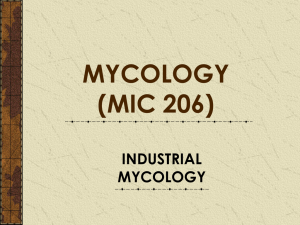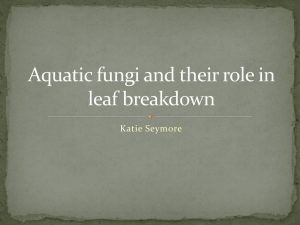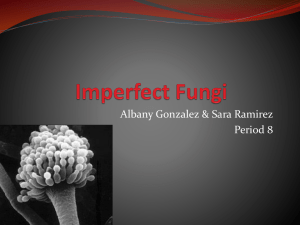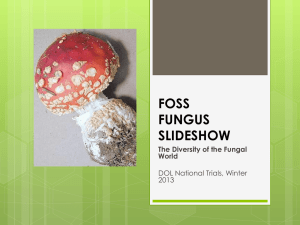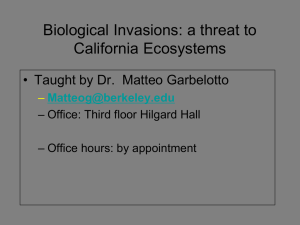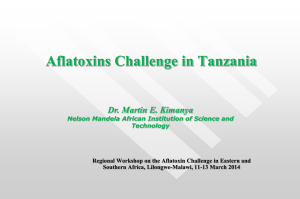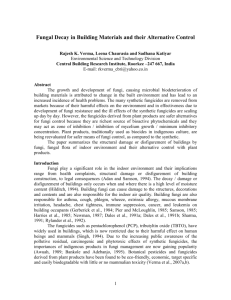Control of Toxigenic Fungi and Aflatoxin with
advertisement
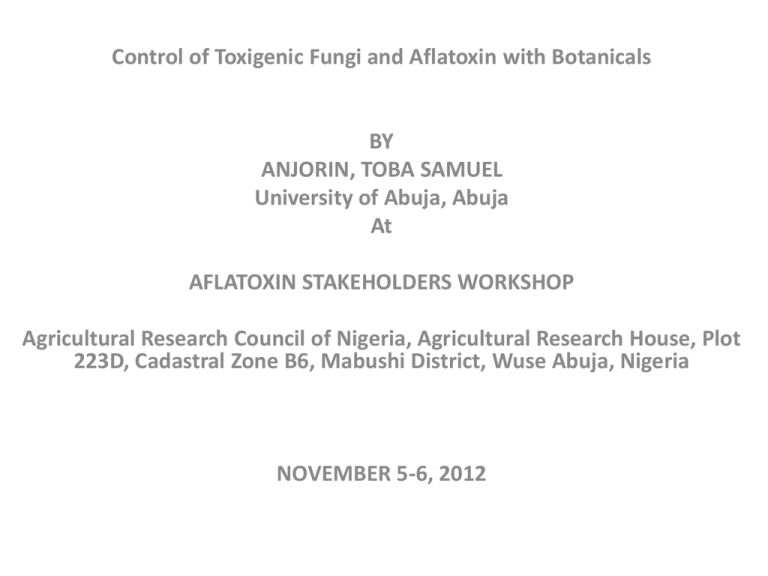
Control of Toxigenic Fungi and Aflatoxin with Botanicals BY ANJORIN, TOBA SAMUEL University of Abuja, Abuja At AFLATOXIN STAKEHOLDERS WORKSHOP Agricultural Research Council of Nigeria, Agricultural Research House, Plot 223D, Cadastral Zone B6, Mabushi District, Wuse Abuja, Nigeria NOVEMBER 5-6, 2012 • INTRODUCTION • Aflatoxins (Aspergillus flavus toxins - B1, B2, G1 and G2) are biologically active secondary metabolites produced by certain strains of Aspergillus parasiticus, Aspergillus nominus and Aspergillus flavus (Cotty et al., 1994). • More than 280 plant species have been investigated for their inhibitory effect on toxigenic Aspergilli and nearly 100 of these plants had some activity on growth or toxin production by fungi (Montes and Carvajal, 1998). Plant leaves, stems, bark, bud, seeds or roots offer potential for fungi control through the production and release of toxic mixtures of phytocompounds/allelochemicals in them (Macias, 1998). • Justification for the use of phytofungicides • Vast fields in developing countries are blessed with abundant plants with fungicidal potential • Botanical fungicides are locally renewable, user-friendly and environmentally safe. (Rotimi and Moems, 2003) Table 1. Plants containing antimicrobial activity (Cowan, 1999) Common name Scientific name Compound Class Activityd Betel pepper Piper betel Catechols, eugenol Essential oils General fungi Ceylon cinnamon Cinnamomum verum Essential others oils, Terpenoids, tannins Garlic Allium sativum Allicin, ajoene General Sulfoxide General Grapefruit peel Citrus paradise Terpenoid Fungi Green tea Camellia sinensis Catechin Flavonoid General Lantana 6,7Lantana camara dimethylesculeti alkaloid n General Mesquite Prosopis juliflora Phenethylamine alkaloid General Olive oil Olea europaea Hexanal Aldehyde General Orange peel Citrus sinensis d-limonene Terpenoid Fungi • • • • • Anti fungal Activity of Some Botanicals Karapynar (1989) reported the inhibitory effect of crude extracts from ground red pepper on the growth of A. parasiticus NRRL 2999 and its aflatoxin production in vitro. Aflatoxin production in fungal mycelia grown for 96 h in culture media containing 50% neem leaf and seed extracts was inhibited by 90 and 65%, respectively (Razzaghi-Abyaneh et al., 2005). Recently, Srichana et al. (2009) studied the efficacy of betel leaf extract on growth of A. flavus and it was found that the extract at 10,000 ppm completely inhibited the growth of this fungus. Similarly Pundir and Jain (2010) studied the efficacy of 22 plant extracts against food associated fungi and found that ginger extract are more effective than other plant extracts. • Awuah and Ellis (2002) reported the effective use of powders of leaves of O. grattisimum and cloves (Sizygium aromaticum) combination with some packaging materials to protect groundnut kernels artificially inoculated with A. parasiticus. • Inhibitory effects of onion extracts on A. flavus growth, with an ether extract of onions, thio-propanol-S-oxide, being demonstrated to inhibit growth (Fan and Chen 1999) Inhibition of Aflatoxin Production by Essential Oils The antifungal activity of essential oils or their constituents such as thymol, carvacrol and vanillin could be in different ways; • The antiaflatoxigenic activity of EOs of different 32 plants are indicated by many researcher (Table 2). For instance, the EOs of Syzygium aromaticum and Lippia turbinate inhibited aflatoxin production. • They could also be added to grain in storage to protect it from fungal infection. These oils could be used as a substitute for chemical fungicides. • They may also prove valuable as ‘lead structure’ for the development of synthetic compounds as they are natural and nontoxic to humans and animals alike (Soliman and Badeaa, 2002; Bluma et al., 2007). Table 3: Plant leaves locally used by Abuja, Nigerian farmers for their stored farm produce against fungi Name Family 1. Iron weed Asteraceae (Blumea perotitiana) 2. Bush tea Lamiaceae (Hyptis suaveolens) 3. Ground star Rubiaceae weed (Mitracarpus villosus)) 4. Lophira Ochnaceae (Lophira lanceolata) Local names Gw*: Sinmisinmi Parts used Whole leaf Ba: Gbagbaje Leaf powder Ha:Tabataba Gw:Basamsin Ba.:Adabwa Ha:Dadoya Gw: Jiji pampi Ba: Olugodotondo Ha:Gogamasu Gw: Gbonrii Ba: Zhimya Nu:Gbetseti Use For seed dressing Whole leaf Fumigant in the farm powder/ produce store Leaf slurry Leaf Seed/tuber powder/extract dressing at low concentration Leaf Yam sett powder/extract dressing • 5.0 Mechanism of Action • (1) The result could be in the form of damage to the enzymatic cell system, including those associated with energy production and synthesis of structural compounds (Conner and Beuchat, 1984 a, b), • (2) Denaturation of the enzymes responsible for spore germination or interference. • 3)Essential oils protect the cells from harmful impact of aflatoxins as they reduce DNA binding formation of aflatoxins. • Utilization of botanicals in fungi management • a.Direct spray applications of various extracts of biologically effective plant products like leaves, stem, roots and whole plants especially for the control of leaf-borne fungi on the field (Preharvest). • B.Soil amendment of the effective plant materials for the control of the soil inhabiting pathogenic fungi like Aspergillus, Fusarium and root-knot nematodes. e.g. amendment of de-oiled cakes of neem and castor (Pre-harvest) • c. Intercropping/mixed cropping of the biologically active plant/ crop with the main crop to minimize the toxigenic fungiinfection incidences (Pre-harvest). • d. Use of botanical based commercial formulations for the pest management in agriculture. • e. Several such formulations based on neem has already been registered in Nigeria and now available for commercial use and export e.g. bionimbecidin Green gold®. (Preharvest such as for seed dressing) and for post harvest in the store) • Formulation of biofungicide • Production of commercial phytofungicides is more sophisticated than the homeproduced crude form. • • Digestion of plant materials The use of variety of solvents such as hexane, ethanol, pentane, methanol or ether singly or in a mixture for fractionating the components or extracting the active compounds in the fungicidal plants. • Once the active ingredient has been extracted and purified, it has to be added to inert compounds. During the process of isolating the active ingredients, it should be bioassay guided (McGuffin, 2001). • A standard of active ingredient from fungicidal plant is required for the registration of commercial botanical fungicide and their subsequent use on a commercial scale. It is a fact that phytochemicals are prone to photo-, microbial- and thermaldegradation if not properly packed or stored. • • In the formulation of plant fungicide, biological activity and its efficacy should be stabilized and further enhanced by the addition of stabilizers, antioxidants and synergists. Certain additives could be added to increase the shelf-life and ease of handling. • Sun screens such as para-amino benzoic acid (PABA) could be added to reduce the photoxidation of most active ingredient by ultra-violet light (Zubkoff, 1999). • CHALLENGES • Collection and utilization of natural products seemed to be expensive in terms of time and labour. • Crude and inadequate processing tools and implements and facilities such as grinding stone instead of a grinder or a blender thus making their preparation full of drudgery. • Scarcity of certain plant materials especially those that people compete for because of its efficacy such as Erythrophleum suaveolens • • Low efficacy of most botanicals due to their brief persistence or short shelf-life as they are easily prone to microbial, thermal or photo degradation. • Bulkiness of some botanical materials during collection, preparation and application, such as 10 kg of neem leaf powder required for amending 100 m2 of tomato field per time. • CONCLUSION • Protocols on production of fungitoxic compounds for large scale production should be developed. Communication between researchers and extension organization should be intensified. Through this, phytofungicide research can be directed at farmers need and the knowledge concerning their use will be provided. • Plant fungicide production could be sequentially integrated into a sustainable crop protection system in the developing countries. Integrated Disease Management strategy of prevention and control of toxigenic fungi and aflatoxins should be considered. • THANKS FOR LISTENING


